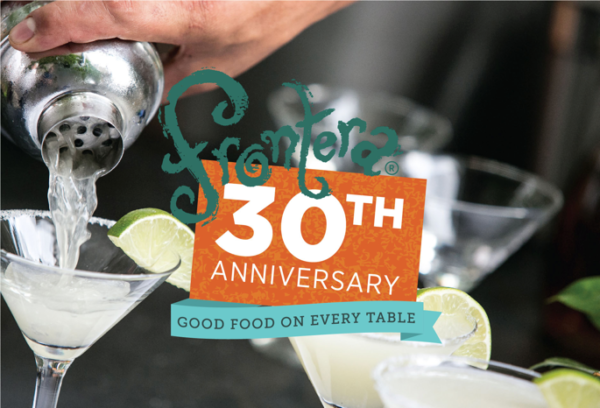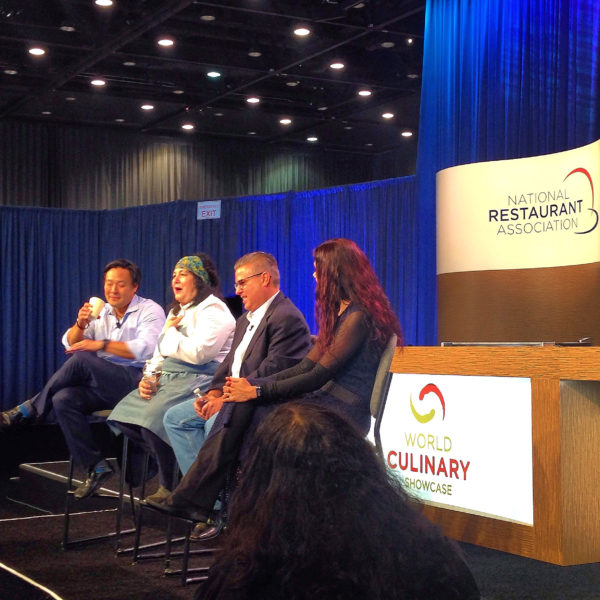by Bob Benenson, FamilyFarmed
When it comes to immigrants’ contributions to American culture, the story often starts with a restaurant featuring the food of the new arrival’s homeland. That happened to be the case for the family of Ming Tsai — whose popularity as a TV chef makes him among the best-known participants in the Frontera 30th Anniversary Celebration, the fundraiser for Chef Rick Bayless‘ Frontera Farmer Foundation and FamilyFarmed that takes place this Sunday (April 30) at The Art Institute of Chicago.
For many years, Ming’s parents — both immigrants from China — owned, and his mother ran, a restaurant in Dayton, Ohio, called Mandarin Kitchen. Ming worked there during his teen years and showed his obvious talent and passion for cooking. But… this is an ethnic food story with a twist.
The reason Ming’s family settled in Dayton was because his father was an aerospace engineer who worked at the nearby Wright-Patterson Air Force Base and helped design the B-1 bomber among other projects. As Ming describes him, “He is literally a rocket scientist.”
Ming followed the education-first philosophy of his parents and started to follow in his father’s footsteps, studying mechanical engineering at Yale University. But cooking was never far from his mind, and though he achieved his Ivy League degree, he embarked on a career that led to his successful Blue Ginger flagship restaurant in Wellesley, Massachusetts; the Blue Dragon in Boston; and a long career as a TV chef that for the past 14 years has propelled his Simply Ming show on public television.

And during his 14th season, one of his guest chefs was… Rick Bayless, a formidable TV chef himself, who has popularized regional Mexican cuisine in the United States since he opened Chicago’s Frontera Grill 30 years ago. (You can view the video of that segment by clicking here.)
Last May, Ming Tsai participated in a panel at the National Restaurant Association Show in Chicago titled America: A Global Melting Pot, with fellow chefs Carrie Nahabedian of Chicago’s Naha; Richard Sandoval, whose eponymous restaurant group is one of the world’s largest; and Rohini Dey of Chicago’s Vermilion. Ming’s comments about ethnic food, a career as a chef and cooking on TV are excerpted below (click here to see a video with all of the chefs’ commentary).
You can meet Rick and Ming at Sunday’s Frontera 30th Anniversary Celebration (click here for more information and tickets). And even if you cannot attend, you can participate in the amazing online silent auction (click here), the proceeds from which will help the Frontera Farmer Foundation and FamilyFarmed expand their efforts to assist family farmers and food entrepreneurs and accelerate the Good Food movement.

Ming on Why More Americans Are Demanding Global Flavors
Global flavors taste better. People are so much more well-traveled. People go to Thailand now or they go to Mexico and they taste the real lemongrass this or the real chipotle that. And when they come back to the States, they’re demanding those flavors. And because this world is so small now, you can get every product so easily… It’s forcing us chefs to do better, which is great, it’s a good pressure to have. And you throw in the whole marketing of the web, of TV, all that, people see new flavors, new techniques, people demand that. It’s keeping us chefs honest which is great.
Ming on the Downside of “Fusion”
I hate the term fusion cuisine, because food is a blending of technique and flavors. Fusion is forced atoms together to make nuclear energy. However, I would go out and say that everyone on this stage, and every top chef in the country is doing their own version of fusion… But I would also say no one up here or anywhere is inventing a cuisine. Everything’s been done before, everything. So don’t fool yourself…
To the young cooks and chefs out there… Learn how you traditionally use certain things from those cultures. I use sesame oil as the best example. In Chinese cuisine, we put a tablespoon of sesame oil in four quarts of chicken stock and that’s all you need. You get a new cook and he’ll take sesame oil and put it on a tuna carpaccio like it’s extra virgin olive oil, you’ll taste sesame oil for four courses, and you’ve ruined the dining experience.
I’ve always said you have to learn the traditional way before you earn the right to start blending, so that’s key. Just because a dish has never been done does not make it a good dish. Maybe peanut butter and escargot should not go together. Right? “Oh my God, it’s a new dish, no one’s ever done this before.” Maybe it shouldn’t be done.

Ming Tsai (left) is the star of Simply Ming, a public TV cooking show that has been running for 14 seasons, and chef-owner of two fine-dining Chinese restaurants in the Boston area. Here he participated in a panel discussion on America’s ethnic food melting pot at the May 2016 National Restaurant Association show, along with (from left) Carrie Nahabedian of Chicago’s Naha, Richard Sandoval of the wide-ranging Richard Sandoval Restaurants group, and Rohini Dey of Chicago’s Vermilion. Photo: Bob Benenson/FamilyFarmed
Ming on Why the Quality of Chinese Food is Better in the U.S.
I think now, like other cuisines, it’s not just Chinese. It’s Szechuan, Hunan. It’s specific chefs coming from specific regions… we’re getting the real chefs here. And when they come here, they’re amazed because the products are much better. It’s the only way to get a Chinese chef to not cook with MSG. I was just in Hunan about a week ago and they’ve got the three powders, the salt, the sugar and the MSG, and they still use it. And the whole rationale… was, “Our quality of meat, our quality of product, is so much lower than you have, we need this.” I’m not going to argue with 1.2 billion, they’re pretty smart. But here we’ve got great product, so you can actually elevate Indian, Chinese and Mexican cuisine.
Ming On Ethnic Fine Dining’s Value Proposition and Con-Fusion
The perception of Chinese food among most Americans when they first arrived here is all these styles of food are cheap, inexpensive, and for $10 I can get a huge plate of food. It’s so hard to change a mindset to then charge 45 bucks a head for similar technique, obviously nicer products…. That’s always been a struggle. But like Richard said, you take baby steps, and once you make a fois gras morel shumai [dumpling], people say, “Oh, there’s fois gras in here, it’s a shumai.” It’s a dim sum, but they start to see that, okay, maybe this is worth the money.” Ideally, when they taste, they’ll think this is worth the money…
The worst food in the world is bad fusion. That’s con-fusion cuisine. That’s lemongrass with sesame oil with Indian curry with Greek yogurt with creme fraiche, boom, vinaigrette! Horrible. Horrible.
Ming on Switching To a Chef Career After Graduating From Yale
Similar to most cultures, Indian families, Jewish families, education was job one. We had three choices: doctor, lawyer, engineer… I was working at my mom’s restaurant in Dayton, Ohio, at age 14, 15, 16, in the Mandarin Kitchen… They knew I had a knack for cooking and they knew I loved, I was passionate, I was happiest when I was cooking with my grandparents and my parents.
And then every summer during college, I started going to Paris… trying to master the perfect baguette… So my junior year, I came back, I sat them down, mom and dad, and said, I want to be a chef. I’m going to finish the degree… My mom… said, “You’re so lucky at a young age that you know your passion, just promise to give 110 percent. I wholly support you.”
My dad, who literally is a rocket scientist, he helped design the B-1 bomber at Wright Patterson Air Force Base, he’s a genius. I look at him and he’s much more pensive that my mom, and he says, “Son, you weren’t going to be a very good engineer anyway. Go cook!” (laughs) I’m, “Wow, Dad, a little sugar-coat.” But he’s right, if you don’t love what you do, you’re going to suck at it, period. And don’t fly in one of the planes I design, right? Use my pans, they’re really cool, or the pressure cooker, but I wouldn’t fly in the plane…
Ming on Being a TV Chef and Emeril Lagasse’s Groundbreaking Role
I was so lucky. All of us say this, I got to ride Emeril’s train. When Food Network first started, we were all horrible on TV… Most of us were like [in a monotone voice], “I like lamb a lot, it’s good.” We were robots. Emeril then brought in “Bam!” He brought in fun… that the mass audience could relate to…
Food Network then went from 13 million households to whatever it is now, 150 million households. But at a certain point, Food Network became all about competition. I’m guilty, I did Next Iron Chef, which was an awesome show until I got eliminated… I ended up leaving Food Network 14 years ago because I still wanted to teach…. That’s all we’re ever doing is teaching… And Simply Ming, I still get to teach…
Does it help business? Of course, it can help business. People see you on TV and it says, Blue Ginger can be found in Wellesley, I’ll get everyone one time. But you’ve still got to produce. You’ve still got to make a great experience. In fact, people often come with a chip on their shoulder and they’ll say, “This better be the best meal I’ve had in my life.” I’m not better than 5,000 other chefs in this country, but because I’m in the black box, they presume this better be the best meal ever. I always joke, “I hope you just ate at McDonald’s or something.” I’m a good chef like everyone else up here, but am I the best chef? Hell, no, not even close.
Ming on Guilty Food Pleasures and Moderation
Fried savory. Anything fried, anything salty. It can be a potato chip, it can be chicharrones, anything fried savory.
I used to binge, but I don’t binge anymore. I’m 52, so you can’t be binging on French fries anymore. Everything in moderation. I’ll say this, it’s so important, eat what you want all the time, but in moderation.
The 2017 National Restaurant Association Show will be held May 20-23 at Chicago’s McCormick Place convention center.
